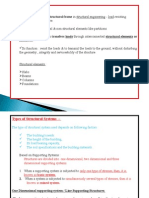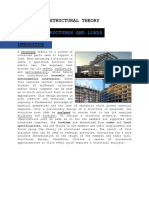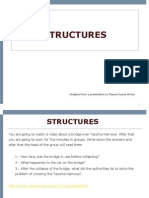Name: - Class: - Structures
Uploaded by
Koo WFName: - Class: - Structures
Uploaded by
Koo WFCOMMONWEALTH SECONDARY SCHOOL
DESIGN AND TECHNOLOGY
2012
Name: ________________ (
1 What are structures?
) STRUCTURES
Class: _______
A structure is something that carries a load and withstands other forces acting on it. You can find structures in many places. All structures have 3 things in common, which are: a) they must resist forces; b) they must not collapse during use and; c) they must hold parts in the right place. Structures are classified as either man-made or natural. Examples:
Natural Structures
Man made Structures
Koo WF
COMMONWEALTH SECONDARY SCHOOL
DESIGN AND TECHNOLOGY
2012
Types of Structures Structures can also be classified as frame or shell structures.
2.1 Frame Structures A frame structure is made up of separate parts of materials, known as members. Members are joined together to form basic shapes such as triangles and rectangles. These basic shapes can then be combined to form more complicated structures. Frame structures are strong but relatively light. Hence they are commonly used for long distance spanning structures such as bridges, and where tall buildings are constructed.
Bone structure Frame Structures 2.2 Shell Structures A shell structure has no frame. Unlike frame structures, the load is not carried by members but by its outer skin. A shell structure is lighter compared to a frame structure and has the advantage of protecting what is inside it. Examples include tin cans and helmets.
Koo WF
COMMONWEALTH SECONDARY SCHOOL
DESIGN AND TECHNOLOGY
2012
In real life, many structures are a combination of frame and shell structures.
Functions of Structures The functions of structures include: a) supporting a load; b) spanning between points; c) containing things and; d) protecting things.
Span
Koo WF
Support
COMMONWEALTH SECONDARY SCHOOL
DESIGN AND TECHNOLOGY
2012
Protect 4 Forces
Contain
Structures are subjected to forces due to their own mass and the loads they carry. They may be subjected to different kinds of forces, depending on the ways loads are applied. Forces that structures may bear include compression, tension, torsion, shear and bending. 4.1 Compression When in compression, the structure is being squeezed as shown in Figure 4.1.
Figure 4.1
4.2 Tension When in tension, the structure is being stretched or pulled as shown in Figure 4.2.
Figure 4.2
Koo WF
COMMONWEALTH SECONDARY SCHOOL
DESIGN AND TECHNOLOGY
2012
4.3 Torsion When in torsion, the structure is being twisted as shown in Figure 4.3.
Figure 4.3 4.4 Shear When subjected to shear forces, the structure is being cut into two by forces acting in opposite directions and at different points from each other as indicated in Figure 4.4.
Figure 4.4 4.5 Bending When subjected to bending forces, the structure bends as shown in Figure 4.5.
Loads
Figure 4.5
A structure has to support its own mass as well as other loads. For example, the wooden bench that you are sitting on now has to carry the mass of the timber from which it is made, as well as your mass. There are two basic kinds of loads:
Koo WF
COMMONWEALTH SECONDARY SCHOOL
DESIGN AND TECHNOLOGY
2012
a) b)
Static load and; Dynamic load (not covered at this level).
5.1 Static Load Static loads are loads that are stationary (not moving). When you sit on the bench, the bench is carrying a static load. Figure 2.1 shows another example of a static load.
Load
Rigidity of Frame Structures Rectangular structures are not rigid. They change shape when subjected to an applied force as shown in Figure 6.1.
Figure 6.1 A triangular structure is more rigid. It can resist the change in shape when a force is applied, due to the equilibrium of forces.
Figure 6.2
Koo WF
COMMONWEALTH SECONDARY SCHOOL
DESIGN AND TECHNOLOGY
2012
6.1 Triangulation A rectangular structure can be made more rigid by constructing it out of triangles. This is known as triangulation. The diagonal members used to increase the rigidity of structures are called bracing members. Some methods of bracing are shown in Figure 6.2A.
Another way of increasing the rigidity of structures is to fix gusset plates to each joint. This is shown in Figure 6.2B.
Gusset plates
Figure 6.2B
Koo WF
You might also like
- Design and Tech - Notes (Syllabus Code - 0445)No ratings yetDesign and Tech - Notes (Syllabus Code - 0445)7 pages
- Lecture 1 Types of Structures and LoadsNo ratings yetLecture 1 Types of Structures and Loads94 pages
- Structures: Structures Classifications: Shell Structures and Frame StructureNo ratings yetStructures: Structures Classifications: Shell Structures and Frame Structure10 pages
- Irune Veintemilla Ochoa - Exercises structuresNo ratings yetIrune Veintemilla Ochoa - Exercises structures7 pages
- Week 1 Review of Statics and Mechanics Introduction To TOSNo ratings yetWeek 1 Review of Statics and Mechanics Introduction To TOS48 pages
- gr.7_technology_worksheets_booklet_memoNo ratings yetgr.7_technology_worksheets_booklet_memo18 pages
- Week 1 Review of Statics and Mechanics Introduction To TOSNo ratings yetWeek 1 Review of Statics and Mechanics Introduction To TOS48 pages
- Week 01-Introduction to Structural AnalysisNo ratings yetWeek 01-Introduction to Structural Analysis84 pages
- Dissertation:-Tensile Structures, P.M.AMAL100% (2)Dissertation:-Tensile Structures, P.M.AMAL39 pages
- Structure Is A Fundamental, Tangible or Intangible Notion Referring ToNo ratings yetStructure Is A Fundamental, Tangible or Intangible Notion Referring To3 pages
- CIEN-2107 Elementary Structural Analysis: Course OutlineNo ratings yetCIEN-2107 Elementary Structural Analysis: Course Outline29 pages
- Strong-Structures-Teacher-Recource-PackageNo ratings yetStrong-Structures-Teacher-Recource-Package24 pages
- 1 - Introduction To Structural Analysis, Types of Structures and LoadsNo ratings yet1 - Introduction To Structural Analysis, Types of Structures and Loads46 pages
- Week 1 Lecture 1 Introduction COURSE OUTLINENo ratings yetWeek 1 Lecture 1 Introduction COURSE OUTLINE35 pages
- Introduction To Structural Analysis-Part 1No ratings yetIntroduction To Structural Analysis-Part 130 pages
- Mechanics of Rubber Bearings for Seismic and Vibration IsolationFrom EverandMechanics of Rubber Bearings for Seismic and Vibration IsolationNo ratings yet
- Reinforced Concrete Buildings: Behavior and DesignFrom EverandReinforced Concrete Buildings: Behavior and Design
- Structures: Structures Classifications: Shell Structures and Frame StructureStructures: Structures Classifications: Shell Structures and Frame Structure
- Week 1 Review of Statics and Mechanics Introduction To TOSWeek 1 Review of Statics and Mechanics Introduction To TOS
- Week 1 Review of Statics and Mechanics Introduction To TOSWeek 1 Review of Statics and Mechanics Introduction To TOS
- Structure Is A Fundamental, Tangible or Intangible Notion Referring ToStructure Is A Fundamental, Tangible or Intangible Notion Referring To
- CIEN-2107 Elementary Structural Analysis: Course OutlineCIEN-2107 Elementary Structural Analysis: Course Outline
- 1 - Introduction To Structural Analysis, Types of Structures and Loads1 - Introduction To Structural Analysis, Types of Structures and Loads
- Introduction to Design of Building StructuresFrom EverandIntroduction to Design of Building Structures
- Mechanics of Rubber Bearings for Seismic and Vibration IsolationFrom EverandMechanics of Rubber Bearings for Seismic and Vibration Isolation
- Modeling and Dimensioning of Structures: An IntroductionFrom EverandModeling and Dimensioning of Structures: An Introduction



























































